Final report for FNE16-846
Project Information
This project investigated whether Swede Midge (Contarinia nasturtii) inflicts less damage on selected cultivars of broccoli (Brassica oleracea var. italica). Swede Midge is a gall-forming fly that feeds on the growing points of many Brassica crops, damaging the ability of the broccoli plant to produce a marketable head.
To do this, we planted two adjacent trials of eight broccoli cultivars. Broccoli cultivars used were ‘Bay Meadows’ (Syngenta); ‘Burney’ (Bejo); ‘Diplomat’ (Sakata); ‘Emerald Crown’ (Sakata); ‘Everest’ (Northrup King); ‘Gypsy’ (Sakata); ‘Imperial’ (Sakata); and ‘Lieutenant’ (Seminis). Plots were managed with typical northeastern certified-organic cropping practices. Working with technical advisor Yolanda Chen her graduate students, we assessed plots for head damage and plant damage using the Hallet scale. While cultivars suffered differently, none of them presented true immunity when facing high Swede Midge pressure, though some were apparently better than others. That said, ‘Burney’ and ‘Lieutenant’ are clearly better than ‘Diplomat’ and ‘Imperial’. This farmer and others noted that they will be using more 'Burney' and 'Lieutenant' cultivars in the future.
Outreach of results was presented at the Vermont Vegetable & Berry Growers Association annual meeting, 1/23/17 and the Northeast Organic Farming Association of Vermont (NOFA-VT) Winter Conference 2/19/2017 among other events.
Our overall objective was to test broccoli cultivars encompassing a relatively broad (though commercially successful) genetic base in the trials, in order to see whether there would be any difference in Swede midge damage between them. The objective for the project was to identify broccoli cultivars that were less affected by Swede Midge. To assess this, at maturity we screened damage based on the Hallett scale of plant damage (a Swede Midge damage assessment scale developed by Dr. Rebecca Hallett of University of Guelph in Ontario) and also for head marketability using traditional market grading standards.
Cooperators
Research
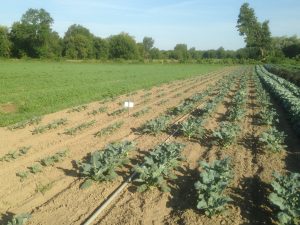
Broccoli cultivars ‘Bay Meadows’ (Syngenta); ‘Burney’ (Bejo); ‘Diplomat’ (Sakata); ‘Emerald Crown’ (Sakata); ‘Everest’ (Northrup King); ‘Gypsy’ (Sakata); ‘Imperial’ (Sakata); and ‘Lieutenant’ (Seminis) were started on 6/10/16 in 150 cell plug flats filled with Vermont Compost Company Fort-V potting soil. On 7/1/16 they were transplanted to the field using a waterwheel transplanter.
Prior to planting, beds were prepared using reciprocating spader and field cultivator for tillage. A cover crop of 12” tall winter rye was incorporated on 5/23/16. Fertilizer of 1200#/A sunflower meal (4-1-1), 300#/A sul-po-mag, and 2#/A boron were incorporated prior to final tillage. On 6/21/16 we started a second round of transplants in the greenhouse, setting them in the field on 7/15/16. Greenhouse methods, field preparation, and plot fertilization were the same for both trial dates.
Twenty plants of each cultivar were transplanted in four rows, 36” between rows, 12” between plants, for a final plot size of 5’ x 12’. Cultivar plots were separated from others of their planting date by 5’ x 12’ plots of bare soil. 6/10 and 6/21 blocks abutted along one edge. Each of the eight cultivars was repeated four (6/10 planting) or five (6/21 planting) times. Each variety was randomly distributed within each replication of 8 cultivars.
Production practices were standard organic vegetable farming methods common in the Northeast. Broccoli cultivars were chosen from varieties in commerce and available untreated. Intervale Community Farm is certified-organic, and the USDA National Organic Program production standards do not allow the use of seeds treated with synthetic compounds even for research purposes. This presented a problem, as my intention had been to trial the four varieties identified as ‘less bad’ by Dr. Hallett in her paper “Host Plant Susceptibility to the Swede Midge (2007).” As a result of the NOP prohibition on treated seed I was only able to use one of the better-performing varieties, ‘Everest’, identified by Dr. Hallett. I had hoped to have ‘Regal’ (Ferry-Morse); ‘Sultan’ (Sakata), and ‘Triathalon’(Sakata), all three having been identified as less damaged in Hallett (2007), but ‘Regal’ and ‘Sultan’ have fallen out of commerce and I could not source untreated ‘Triathalon’.
Aside from ‘Everest, I selected other cultivars after conferring with several broccoli experts. Dr. Thomas Bjorkman at Cornell was particularly helpful and supportive, identifying several cultivars that his work on behalf of the Eastern Broccoli Project identified as notably tolerant and resilient in eastern environmental conditions (‘Bay Meadows’, ‘Burney’ and ‘Lieutenant’). He also identified varieties that were the most widely planted in the Northeast (‘Diplomat’, ‘Emerald Crown’) and those he thought might be a good fit based on certain morphological traits (‘Imperial’). ‘Bay Meadows’, ‘Gypsy’, and ‘Lieutenant’ are varieties ICF has grown in recent years.
Overall, I wanted to include a broad genetic base in the trials, so that we would cover more ground. Without a deep knowledge of broccoli genetics, as a proxy for diversity I sourced cultivars from several of the major broccoli breeding companies.
We intentionally located the broccoli research plots adjacent to 3/4 acre of Brassica crops. In order to make certain we had high Swede Midge pressure in the trial plots, we took advantage of the typical generational succession and population buildup we've observed in our Brassicas over multiple seasons.
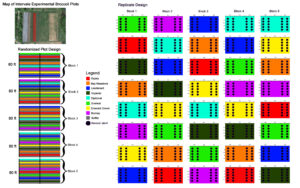
After planting, trial plants were weeded with tractor cultivation and hand hoeing at required intervals throughout the growing season. Plots were sprayed for flea beetles once with Entrust (Spinosad) + Nufilm P adjuvant on 7/20/16. Research by Chen and Hallett demonstrated that Spinosad has no measurable

effect on Swede midge, so this did not likely influence the results of the trial. Plots were irrigated as required, a frequent occurrence in the dry 2016 summer on our sandy Hadley fine sandy loam.
Two Swede Midge monitoring traps were placed in the research plots to track population. Lures were changed according to recommended schedule.
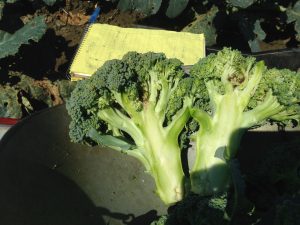
Prior to full maturity of the plants, we made a preliminary plant damage assessment using the Hallett scale. At the beginning of heading, we made a second Hallett assessment. The Hallett scale assesses damage on a four point scale (0 = no damage) of overall plant morphology: how much of the growing point of the plant has been affected by Swede Midge and the general health appearance of the plant. As growers, we were interested in examining head marketability specifically, partially to see whether there would be divergence from the Hallett scale conclusions, though mostly we wanted to focus on whether a grower could actually sell the broccoli head in question, the most important and relevant point for producers.
To assess head damage, plots were evaluated three times a week at maturity, an interval typical of our alternating day harvest schedule for autumn fresh-market, crown-cut broccoli. In each plot of 20 plants we tallied all mature, marketable heads. Marketability was determined by farmer experience, a seasoned but admittedly somewhat imprecise measure that includes head smoothness, bead uniformity, stem morphology, freedom from scarring, a lack of bead rot and a minimum measurement across the crown of 3.5". While some of these criteria could be influenced by other conditions (e.g. heat, insects, diseases), our dry conditions greatly reduced overall disease pressure, few other insects were present in large numbers (excepting flea beetles noted above), and the other symptoms (scarring, particulars of head and stem deformity) occurred in such manners that Swede Midge was the nearly certain culprit. Marketable heads were split in half for internal observation, as heads looking acceptable on the surface may well have sufficient internal Swede Midge damage to be rendered unmarketable. Tallies from each plot were aggregated with other like cultivars from other replications for purposes of analysis.
Intervale Community Farm is certified-organic, and the USDA National Organic Program production standards do not allow the use of seeds treated with synthetic compounds even for research purposes. This presented a problem, as our intention had been to trial the four varieties identified as ‘less bad’ by Dr. Hallett in her paper “Host Plant Susceptibility to the Swede Midge (2007).” As a result of the NOP prohibition on treated seed we were only able to use one of the better-performing varieties, ‘Everest’, identified by Dr. Hallett. We had hoped to have ‘Regal’ (Ferry-Morse); ‘Sultan’ (Sakata), and ‘Triathalon’(Sakata), all three having been identified as less damaged in Hallett (2007), but ‘Regal’ and ‘Sultan’ have fallen out of commerce and we could not source untreated ‘Triathalon’.
Aside from ‘Everest, we selected other cultivars after conferring with several broccoli experts. Dr. Thomas Bjorkman at Cornell was particularly helpful and supportive, identifying several cultivars (‘Bay Meadows’, ‘Burney’ and ‘Lieutenant’) that his work as coordinator of the Eastern Broccoli Project identified as notably tolerant and resilient in eastern environmental conditions. Dr. Bjorkman also identified varieties that were the most widely planted in the Northeast (‘Diplomat’, ‘Emerald Crown’) and those he thought might be a good fit based on certain morphological traits (‘Imperial’). ‘Bay Meadows’, ‘Gypsy’, and ‘Lieutenant’ are varieties ICF has grown in recent years. From that research we selected the eight cultivars featured in our 2016 trial: ‘Bay Meadows’ (Syngenta); ‘Burney’ (Bejo); ‘Diplomat’ (Sakata); ‘Emerald Crown’ (Sakata); ‘Everest’ (Northrup King); ‘Gypsy’ (Sakata); ‘Imperial’ (Sakata); and ‘Lieutenant’ (Seminis).
While the 2016 growing season was hot, dry, and replete with flea beetles, overall growth of the plot broccoli was typical of many growing seasons. With the elevated temperatures, it is likely that some of the morphological defects observed during vegetative plant growth and seen in heads at harvest is a result of heat stress. Despite this many distinctive Swede Midge impacts were noticed throughout the plots, and remained the object of the screening.
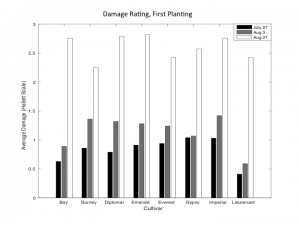
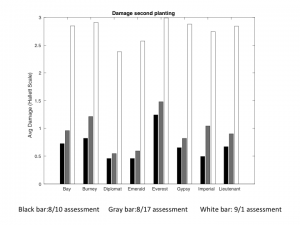
Our Hallett Scale assessments show little difference between cultivars. While there is variation, by the time harvest arrives at the final assessment, nearly all of the plants are displaying severe Swede Midge damage. Interesting to us is how the Hallett Scale ratings and the head marketability assessment do not appear to be strongly related: several cultivars scoring lower damage on the Hallett Scale produced far fewer marketable heads. Again, as growers, our primary focus is on head marketability, so those are the data that interest us most.
Initially we collected weights of marketable heads. While interesting to compare the measured totals, ultimately the most important thing to the grower is whether the plant will make a decent head. Broccoli production is a malleable thing, with some growers setting high plant populations with smaller target heads, and some growers spacing plants wide with fewer, large crowns the objective. If one were able to identify a Swede Midge tolerant broccoli, one could then manipulate the plant population and spacing to achieve a different head size/tonnage per acre. We concluded that marketability presence/absence was much more important to collect than head size information. That said, head marketability is a subjective quality, and variation in my assessment may have skewed the data one way or another.
Many other things could influence the outcome of the trial as well. Since the 8 cultivars all had somewhat different days-to-maturity, that also seems like a notable possibility. However, our results had a mix of maturation dates at both the high and the middle-low ends of the scale, so this seems likely to have been of minimal influence alone.
Unfortunately, we found after the fact that our monitoring trap lures were ineffective, having been compounded incorrectly at the supplier. Consequently, we have no population data to cross check with damage observations. Our UVM colleagues suffered the same fate in their use of the same lures. Visual observations of the plots, based on many years of looking at broccoli plants for Swede midge damage combined with observations of damage in the plots suggest that the overall Swede midge population was high relative to many other seasons.
Our 2016 results showed that Burney, Lieutenant, and Gypsy produced somewhat more marketable heads than the others. Diplomat was clearly the worst, with very few saleable heads in either planting. Imperial and Everest were
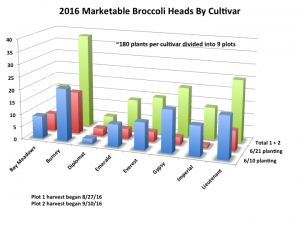
minimally better. Interestingly, Everest was the one more-promising cultivar from Dr. Hallett’s earlier work. In the middle were Bay Meadows and Emerald Crown.
Worth noting is that even the top performer 'Burney' made only 27% marketable heads. Such a low marketability result is economically impossible to justify, and speaks to the fact that even in the face of a more favorable cultivar, a multiplicity of strategies (e.g. crop rotation, exclusion, timing) need to be employed in order to produce broccoli with some degree of certainty when facing Swede Midge pressure.
Unfortunately for Northeastern broccoli growers, we didn’t find a supremely resistant variety. That said, our data analysis points to some difference in cultivar susceptibility. I am please that we had wide variation in number of marketable heads. 'Burney' and 'Lieutenant' are clearly better than 'Diplomat' and 'Imperial'. Interestingly, in the face of the recorded higher Swede Midge damage in the 6/21 planting, the difference between the top performers and the worse performers was more significant.
ICF learned information that is useful: 'Burney' and 'Lieutenant' appear to be more worthy of inclusion in our broccoli planting, as they seem likelier to succeed. We used them in our 2017 field production and had our most successful broccoli crop in many years, anecdotal though that may be.
Worth noting is that we don't know why our better cultivars are better, or why the worse are worse. Are they generally more resilient, having little to do with Swede Midge? Will the tested cultivars perform similarly in a normal production system where they might be the only cultivar, or is there some sort of preferential attack / trap crop phenomenon at work where the Swede Midge only ignored the successful cultivars because the liked other cultivars more?
We did not assess for underlying plant morphology difference, though this might be an interesting line of inquiry: are plants with more spreading habits, leafier habits, upright growth, darker green pigment, waxier leaves, etc., more or less susceptible as a rule? My hope for our research was that we would be able to see a common morphological theme among the better performers and seek out additional varieties with those common traits. This would be the best outcome from a grower perspective, as it would lead to easier identification of future suitable cultivars, but I was unable to draw any such conclusions with my untrained eye.
Lastly, it is unfortunate that our monitoring traps were impotent, as we cannot compare our 2016 Swede Midge levels with those Dr. Chen has from our fields in prior seasons. While our results show outcomes under what I believe to be high Swede Midge pressure, I can’t say that for certain. That said, many growers, our farm included, would likely use less-susceptible varieties in conjunction with other Swede Midge management strategies such as rotation (even if a short distance), timing of planting, row covers, and so forth. I would like to see how these cultivars behave when facing lower Swede Midge pressure, but again, this is only possible to assess when monitoring traps record a lower level infestation.
Education & Outreach Activities and Participation Summary
Participation Summary:
Formal workshop presentations:
Vermont Vegetable & Berry Growers Association annual meeting, 1/23/17. 15 minute presentation and power point slide show covering project methods and results to audience, most of whom are commercial vegetable producers, with the remainder agricultural educators/service providers. Official conference 1/23/17 conference attendance was 179 farmers + service providers, so number hearing the talk probably totaled 160-170.
Northeast Organic Farming Association of Vermont (NOFA-VT) Winter Conference 2/19/2017. Panel participant with presentation and power point slides in session, "The Swede Midge Situation in Vermont: Biology Basics and Management Updates." Covered results from 2016 field trials, as well as other certified-organic management approaches. Workshop attendance was 35-40 total, probably 10 commercial growers and 2 service providers.
Consultations and conversations with many in the industry. These include many contacts with commercial growers, informally at conferences, via email and telephone, as well as reaching out to commercial vendors in the seed industry to make them aware of Swede Midge and also the differential damage that may have a genetic basis. I have also discussed results at length with educators and agricultural service providers at UVM Extension, U-Mass Extension, and Cornell Cooperative Extension. These included summary discussions sending links to the SARE status reports, sharing powerpoint slides, and making suggestions on Swede midge management information being shared by Extension educators.
While not part of the FN16-846 grant, I ran a similar trial on our farm in the summer of 2017. I am compiling results and expect to share the combined data from the two years via the Vermont Vegetable and Berry newsletter published biweekly by UVM Extension Vegetable Specialist Vern Grubinger.
Learning Outcomes
From the VVBGA 2017 annual meeting evaluation general awareness of Swede Midge and broad management approaches are the most widely reported; a few comments about adopting new broccoli cultivars. From the same survey, 52 farmers reported that they will do something new as a result of my presentation. In conversation, I've spoken with 4 (that I specifically recall) larger broccoli growers that are testing our better broccoli cultivars based on this work, and had many shorter conversations with growers and service providers.
Project Outcomes
The primary project outcome sought in the grant was to assess whether cultivar appeared to make a difference in Swede Midge damage. The result of our 2016 trial suggest that cultivar makes a substantial difference.
Even in the absence of iron clad results, and the mixed signals indicated by our non-SARE-funded 2017 trial, the difference between the worst performing cultivars and the best performing cultivars was startling and unmistakable. The results suggest a strong genetic factor at work, though the basis of that resistance/susceptibility to damage is impossible to discern from our work. It points out another area for future research work to determine which cultivar characteristics are mostly closely linked with damage and resistance to it.
On a practical level, ICF has changed our cultivar selection to that of the two most promising varieties in our 2016 research trial. While impossible to assign causality to our change of cultivars, based on our 2017 field experience, we made a good decision. Our 2017 broccoli crop was the best in about a decade. Identifying the winning cultivar 'Burney' may have contributed to our nearly 7000 lbs fall broccoli yield, nearly twice the 3600 lbs in 2016, which was more typical of our recent seasons. This equates to nearly $7000 value in additional broccoli for our farm in one year. As a management strategy, changing cultivars is truly excellent, since our yield bump, if attributable to cultivar, cost us nearly nothing except additional harvest and packing labor, the place we want to increase costs. All of our production expenses for irrigation, seed, fertility, weed control, etc., were otherwise unchanged.
I have had conversations with several other growers who have now changed or plan to switch their cultivars to the two identified as most resistant to damage in our 2016 trial. I suspect that other growers may well be interested in the results as Swede Midge spreads throughout the region. Many parts of Vermont, and most of the Northeast, have yet to welcome Swede Midge to their area. The USDA forecasts that the entire region will eventually have it, though, and small-scale and organic broccoli producers will be looking for solutions.
One of the appealing results of this project is that I think more growers and researchers are on the lookout for Swede Midge. Some key seed representatives in the industry are now aware of it who weren't before, and also many Extension educators and agricultural service providers.
I hope that one of the outcomes will be that researchers investigate the role of cultivar in Swede midge damage, and more generally, pay more attention to the role that breeding can play in insect pest management. Breeding for disease management is commonplace, while breeding for insect tolerance is relatively rare. I have discussed the role of genetics in broccoli and Swede Midge with several researchers and breeders not currently involved with Swede midge. Dr. Chen's lab continues to be interested in genetics and traits that may serve as attractive or repellant to Swede midge, and this work contributes to the data in those investigations.
Overall, I think that our project was well conceived and generally successful. The field trials came together well, the collaboration with Dr. Chen's lab worked well, and we produced some interesting and useful results. ICF will continue to try to identify promising cultivars of broccoli, which should be something useful to us (as cultivars move in and out of commerce with alarming frequency) and also useful to others through the Northeast as more broccoli growers contend with Swede Midge.
It would have been great if the Swede Midge lures we purchased had worked as advertised, but we had enough observational data to safely say that we had plenty of insect around during the trial. It was helpful that we recognized it early enough and were able to use on-farm observation as a proxy for the trapping. Having a plan ahead of time for workarounds is something I will give more thought to for the future.
Our collaboration with Dr. Chen's lab was facilitated by having worked together on shared Swede Midge for other projects. Having an ongoing relationship with researcher(s) interested in a topic of farm concern is something I recommend to growers, and there is no substitute for a willingness to host on-farm trials. You are more likely to figure things out for yourself with other researchers working on the problem.
In hindsight, it was folly of me to plan for a mid-summer field day for a single-purpose cultivar trial: Swede Midge isn't widespread enough yet to garner a lot of interest, and the few heavily-impacted commercial growers are the farmers I'm in contact with on a regular basis and would be the least likely to attend during a busy time of year.
I hope that one of the outcomes will be that researchers investigate the role of cultivar in Swede midge damage, and more generally, pay more attention to the role that breeding can play in insect pest management. Breeding for disease management is commonplace, while breeding for insect tolerance is relatively rare. I have discussed the role of genetics in broccoli and Swede Midge with several researchers and breeders not currently involved with Swede midge. Dr. Chen's lab continues to be interested in genetics and traits that may serve as attractive or repellant to Swede midge, and this work contributes to the data in those investigations.
I think that there would be value in having a much larger study of broccoli cultivars and Swede Midge undertaken by a research station and several on-farm collaborators. Leveraging involvement from the big multinational broccoli breeders would be a real boon to future research, as they could provide cultivars with both similar and distinct parentage, which might permit one to draw firmer conclusions about the basis of resistance and susceptibility to damage, and link those with plant characteristics, thereby allowing one to predict susceptibility based on parentage or plant characteristics. This would take a lot more money and other resources, but it is exactly the kind of pest control research that results in truly sustainable solutions.